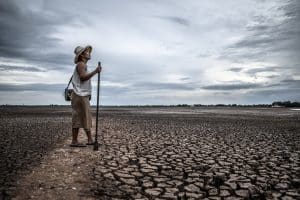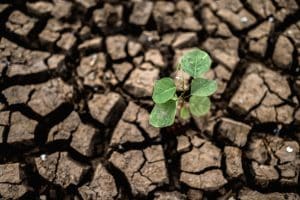How climate change is impacting food security

Climate change significantly impacts food security by causing crop failures, altering weather patterns, and increasing food prices, necessitating adaptive farming practices and effective government policies to safeguard food supplies.
How climate change is impacting food security represents a growing concern for communities around the world. What does a hotter planet mean for our food supply and the people who rely on it? Let’s dive deeper into this crucial issue.
The connection between climate change and food security
Climate change has a significant impact on food security worldwide. As global temperatures rise, the conditions for growing food are changing. Droughts, floods, and unpredictable weather patterns threaten our crops. Farmers are facing challenges that can lead to food shortages and increased prices. The connection between climate change and food security is more vital than ever to understand, as it affects communities around the globe. Food security relies on a stable climate for agriculture. When the climate is erratic, so is food production.
The effects of climate change on agriculture
The agricultural sector is one of the first to experience the consequences of climate change. Here are some key effects:
- Decreased crop yields: Higher temperatures can reduce the amount of food that farmers can produce.
- Increased pests and diseases: Warmer weather can lead to more pests, which can damage crops.
- Water scarcity: Droughts result in less water for irrigation, stressing the plants and reducing harvests.
- Soil degradation: Changing patterns of rainfall can lead to erosion and nutrient loss in the soil.
Climate change isn’t just a future issue. It is affecting crops today. Common foods, like wheat, rice, and corn, are under threat due to shifting climate conditions. Farmers are finding it harder to grow these staples reliably. This jeopardizes nourishment for millions.
Another crucial aspect is the inequality in how climate change impacts different regions. Developing countries often feel the effects more severely. These nations usually depend heavily on agriculture for their economy and food supply. When faced with climate challenges, they lack the resources to adapt quickly. As a result, food insecurity can increase, leading to potential humanitarian crises. This cyclical challenge makes understanding and addressing the connection between climate change and food security imperative for global stability.
Efforts must be made to educate and equip farmers with sustainable practices. Utilizing innovative techniques can help mitigate adverse effects. Strategies such as crop rotation, improved irrigation, and pest management can make a significant difference. Embracing technology and sustainable methods will enable farming communities to adapt to the changing climate, ultimately safeguarding food security for the future.
How rising temperatures affect crop yields
Rising global temperatures have a profound effect on crop yields around the world. As the earth heats up, many crops struggle to grow in the heat. Farmers find that higher temperatures can cause plants to wither and die. It’s not just about getting hotter; it’s also about how these temperatures affect water supplies and soil health.
Direct impacts of heat on crops
When temperatures increase, crops can face several challenges. Some of the most critical effects are:
- Reduced germination: Seeds may not sprout if the soil is too warm.
- Increased evaporation: Hotter days lead to quicker water loss from the soil, stressing plants.
- Heat stress: Plants can shut down during extreme heat, leading to reduced photosynthesis.
- Shortened growing seasons: Higher temperatures can change the length of time plants can grow.
Hot weather can lead to a domino effect on food production. For instance, when crops don’t produce well, it can lead to higher food prices. This is troubling for communities that rely on affordable food. Not only does it affect farmers, but it also impacts consumers.
Additionally, rising temperatures can alter where certain crops can thrive. For example, regions that once grew corn may become unsuitable as temperatures exceed limits tolerable for these crops. Farmers might need to adapt by changing what they grow. This shift can involve risks, as new crops require different skills and resources. Transitioning takes time and support to ensure successful adoption.
As we look at these challenges, it’s essential to promote resilience in agriculture. Sustainable practices can help mitigate some of the effects of rising temperatures. By adapting farming techniques, such as using drought-resistant crop varieties, farmers can improve their chances of maintaining yields despite the changing climate. This approach is vital for securing food supplies in the face of climate change.
The impact of extreme weather events on agriculture

Extreme weather events have a serious impact on agriculture worldwide. From hurricanes to droughts, these events disrupt farming practices and threaten food production. Farmers are increasingly facing challenges that arise from unpredictable weather patterns. The influence of these extreme conditions on crops and livestock can be devastating, leading to food shortages and economic difficulties.
Types of extreme weather events
There are several extreme weather events that can harm agriculture:
- Flooding: Heavy rains can overflow rivers and saturate fields, drowning crops.
- Drought: Extended periods of little rain can dry out soil and stress plants.
- Heatwaves: Excessive heat can cause crops to wither and lead to lower yields.
- Hurricanes: Strong winds and heavy rain from storms can destroy entire fields.
Each type of extreme weather has its own set of challenges. Flooding can lead to soil erosion and nutrient depletion, making recovery difficult. Drought, on the other hand, shrinks available water, stressing crops and livestock alike. This stress can lead to reduced food quality and increased prices, affecting everyone from farmers to consumers.
Moreover, extreme weather events are becoming more frequent due to climate change. As the climate continues to shift, farmers must adapt to a new reality. Some may need to change their crops or alter their farming methods. Understanding how to manage these risks is essential for developing effective agricultural strategies.
In response to these challenges, farmers can adopt various strategies to mitigate the effects of extreme weather. Implementing crop rotation, improving drainage systems, and investing in drought-resistant seeds are a few ways to enhance resilience. Educational programs can also help farmers better prepare for these challenges. By fostering adaptive practices, the agricultural community can work to safeguard food supplies in this changing climate.
Adapting farming practices to climate challenges
Adapting farming practices to climate challenges is essential for ensuring food security. As climate change continues to affect weather patterns, farmers face the need to adjust their methods. This can include new techniques that help crops survive harsher conditions. Understanding how to make these changes can empower farmers to maintain stable food production.
Innovative farming techniques
Many farmers are turning to innovative practices to help them cope with climate challenges. Some effective methods include:
- Crop rotation: Alternating the types of crops grown preserves soil health and reduces pest buildup.
- Conservation tillage: Minimizing soil disturbance helps retain moisture and reduces erosion.
- Drought-resistant crops: Planting varieties that can withstand less water ensures better harvests during dry spells.
- Agroforestry: Integrating trees and shrubs into farmland provides shade and reduces temperature extremes.
These practices not only adapt to the changing climate but also improve overall farm resilience. By caring for the land better, farmers can ensure that their crops grow strong and healthy.
Additionally, technology plays a crucial role in adapting farming practices. Tools such as weather forecasting and soil monitoring systems allow farmers to make informed decisions. For example, they can determine the best times to plant or irrigate, maximizing their yields even in uncertain conditions. Technology can also support precision agriculture, where farmers use data to optimize field management.
Collaboration among farmers, researchers, and policymakers is vital. Sharing knowledge and resources leads to improved practices tailored to specific regions and crops. Workshops and training sessions can help farmers learn about new techniques, making adaptation easier. As climate challenges persist, it is clear that staying informed and connected is key to maintaining food security in the future.

The role of policy in ensuring food security
Policy plays a critical role in ensuring food security for communities worldwide. Effective regulations can help stabilize food supply chains, support farmers, and guarantee access to affordable food for everyone. Policies to address climate change and its impacts are increasingly vital as the challenges of food insecurity grow.
Key policies for food security
Several important policies contribute to improving food security:
- Agricultural subsidies: Financial support for farmers helps them maintain production levels and reduce prices for consumers.
- Trade agreements: Fair trade policies promote international cooperation, allowing for the import and export of essential food items.
- Food assistance programs: Government programs provide nutritional support to low-income families, ensuring they have access to healthy food.
- Research funding: Investing in agricultural research promotes the development of sustainable farming practices and crop resilience.
These policies can significantly impact the ability of countries to feed their populations, especially during times of crisis. For example, during natural disasters or economic downturns, a strong food policy can help mitigate the effects on food supply.
Moreover, community engagement is essential in shaping effective food policies. Policymakers must consider the needs and knowledge of local farmers and consumers. By working together, communities can better address food insecurity and develop tailored solutions.
Additionally, global cooperation is necessary. Issues like climate change, trade, and migration all affect food security and require coordinated efforts across countries.
Global frameworks can help share resources and knowledge, ultimately leading to better outcomes for food security worldwide. As the need for sustainable solutions grows, the role of well-designed policies becomes even more critical in maintaining a stable food supply.
FAQ – Frequently Asked Questions about Food Security and Climate Change
How does climate change affect food security?
Climate change impacts food security by altering weather patterns, leading to crop failures and increased food prices.
What can farmers do to adapt to climate challenges?
Farmers can adopt innovative practices like crop rotation, conservation tillage, and planting drought-resistant crops to adapt successfully.
Why is government policy important for food security?
Government policies provide the support needed for farmers, promote access to food, and help manage sustainable agricultural practices.
How can communities support food security initiatives?
Communities can advocate for supportive policies, participate in local agriculture, and educate others about food security issues.






